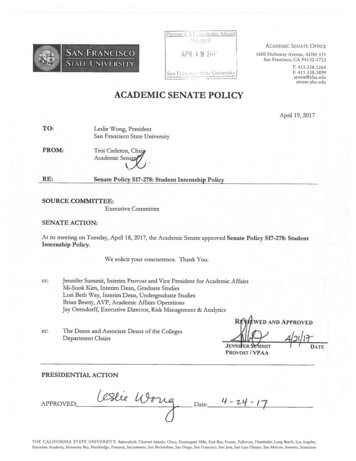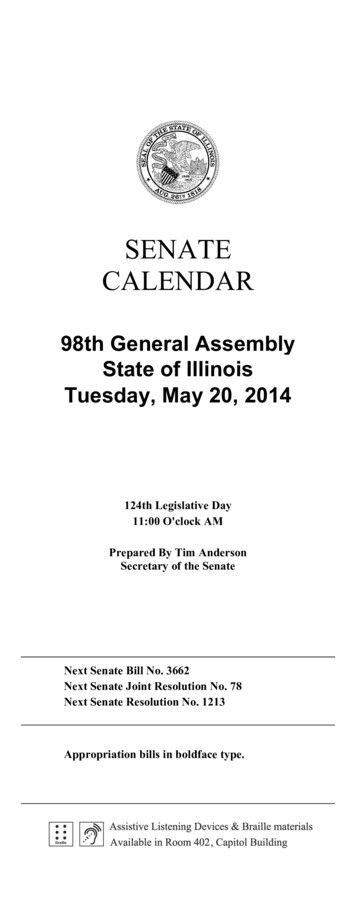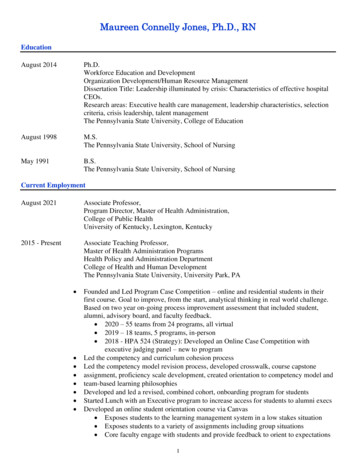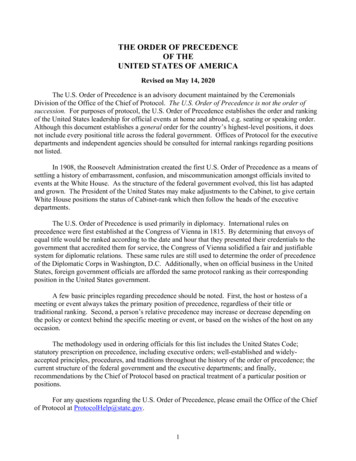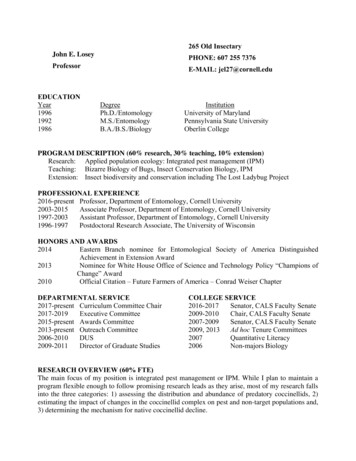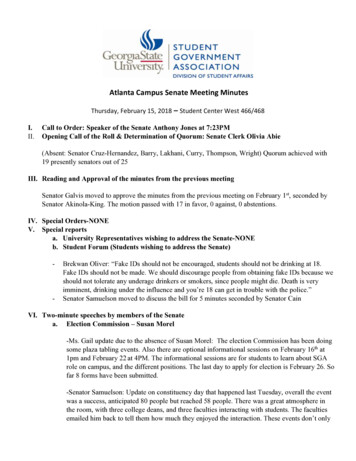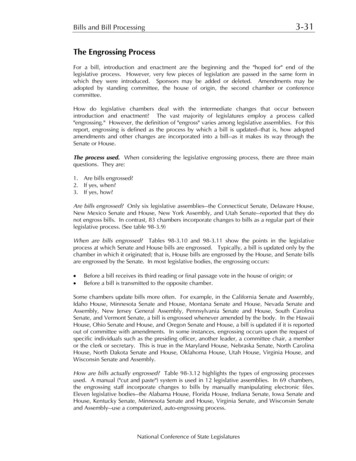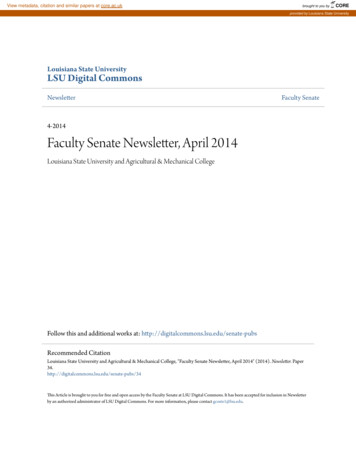
Transcription
View metadata, citation and similar papers at core.ac.ukbrought to you byCOREprovided by Louisiana State UniversityLouisiana State UniversityLSU Digital CommonsNewsletterFaculty Senate4-2014Faculty Senate Newsletter, April 2014Louisiana State University and Agricultural & Mechanical CollegeFollow this and additional works at: ed CitationLouisiana State University and Agricultural & Mechanical College, "Faculty Senate Newsletter, April 2014" (2014). Newsletter. 34This Article is brought to you for free and open access by the Faculty Senate at LSU Digital Commons. It has been accepted for inclusion in Newsletterby an authorized administrator of LSU Digital Commons. For more information, please contact gcoste1@lsu.edu.
FACULTY SENATEMonthly NewsletterPresident’s WelcomeIf there were ever any doubt that the favorite virtue of higher education leadershipis that of unanimity, skeptics would need to look no further than the apparentadministrative love fest that accompanied the announcement of the confidently denominated WISE plan (the “Workforce and Innovation for a Stronger Economy”blueprint), a loosely defined array of proposals and prophecies that center aroundthe currently pending HB1033, sponsored by Lake Charles power broker Charles “Chuck” Kleckley.Wisdom might come at no charge other than that of study and experience,but the WISE plan strikes a hard bargain withacademe: the ex nihilo delivery of 40,000,000.00 in exchange for measuring university merit by what HB1033 blithelycalls “degree and certificate production” in “high demand fields” allegedly pertinent to the “state’s future workforce andinnovation needs.” No “degree” or “certificate” is required to see that the WISE program aims, if nothing else, to change thetone and the missions of universities by prioritizing vocation -specific preparation over wide -ranging, altruistic teachingand research.What is perversely impressive about the WISE initiative and the happy -puppy- like response to it is that the stakes are sovery, very low. Setting aside the question of where the 40M was found and overlooking the apparitional quality of a planthat emerged without any publicly accessible discussion, the economic impact on university budgets will barely push theindicator needle. 40M for three dozen Louisiana campuses, all of which will surely scramble for these dollars, will start littlemore than a stampede. At best, it will fund new careers for thirty or so “Associate Vice- Chancellors for WISE.” Yet, despiterealizing that a very small carrot had replaced the broken stick of a declining gubernatorial regime, higher educationleadership rushed to the celebrations (and into group photographs with all the key players, including the Governor).Clever leaders, admittedly, found ways to tweak and finesse the low bid buyout offer that is WISE. The buoyantly strategicleadership of the University of Louisiana System unfurled a scroll of pro -WISE ovations from its nine campus Presidents,thus showing that the plan could be interpreted as applicable to nearly any initiative. ULS officialdom then began publiclyaffirming the value of the liberal arts. Southern University leadership opined that the WISE plan was fine and dandybut should be thoroughly revised so as to encourage smaller institutions. All of these carefully worded proclamationsingeniously endorsed the WISE plan while opening the possibility of its dilution and dissipation. Words questioning thefundamental premises of the WISE plan, however, remained innumerable, the count being zero.Volume 5, Issue 6:April 2014NATIONAL SPOTLIGHT ONHIGHER EDUCATION PENSION REFORMViewers of the American Heroes Channel hit seriesCodes and Conspiracies will find no surprise in thediscovery that NASH, the National Association ofSystem Heads, manages the flow of information to thepeople that it serves through a web site that can onlybe explored with a login and a password. Comprised ofthe top executives of major university systems, NASHis the most exclusive of clubs for putatively publicofficials. Of course, not every secret society indulgesin hidden unspeakable acts; occasionally those whohaunt the shadows try to do something helpful. So itis that NASH has announced its intention to conduct anational study of retirement plans for higher educationprofessionals. The study seeks to analyze the mannerin which such pension plans are funded; the types ofprograms offered; and the relation of those plans topost retirement health benefits. The roving eye of theweb wanderer cannot help but be amazed to notethe heavy representation of Louisiana officialdom inNASH; included on its ten member board are no lessthan University of Louisiana System President SandraWoodley and former LSU Chancellor, now ColoradoState University System Chancellor Michael Martin.Their Louisiana experience has surely schooled thesetwo admirably outgoing insiders in the sad science ofdeficient retirement plans. The Newsletter has greathopes that these vigorous administrators will drive theNASH study to a quick and revelatory completion.Faculty would do well to review and to speak out concerning the WISE plan and its attendant legislation. The proposedWISE management arrangements will inhibit faculty as well as public access to policy decision-making that will affectcurricula. The WISE Board will operate as a select committee hidden within the Board of Regents. Anyone acquainted withthe Regents’ approach to information distribution will understand that announcements concerning and access to WISEBoard meetings will disappear behind a permanently outdated web page and a retracted public relations department.Comprised of system heads and three state economic and workforce development officials with no faculty, community,or student representation, the proposed WISE Board is at best exclusionary and at worst a machine by which a handful ofstate employees can quietly intimidate institutional leaders. The WISE bill anoints those curricula that produce workersin four - or five- star fields as determined by the Louisiana Workforce Commission, a gubernatorial prefecture which lacksany long term record for predicting job prospects, let alone promoting workers’ rights. The four - and five- star rankingnomenclature, borrowed from investment ranking services such as S&P or Morningstar, fits awkwardly with discussionsof human beings. Occupations that concern themselves with freedom of thought, basic research, or selfless service fallbeneath this heaven of good fortune. Speaking of heaven, the calling of pastor doesn’t make it into the materialist galaxyof stellar jobs.What is most curious about the WISE phenomenon is that it may well increase faculty sympathy for universityadministrations. The highly talented but marginally neurotic way in which the top education managers tried and continueto try to massage the WISE bill—to say, in effect, “yes, we’ll take the money, but we’ll find some way to tie up the attachedstrings in the tangled rhetoric of the academic diversity so that the program will go nowhere except into the bank”—mayhelp faculty to recognize that administrations are just as beaten down as are rank -and- file educators, although, perhaps,the top dogs are a bit better for taking the abuse.Mike Martin returns toretirement plan action.ADMINISTRATIVE RAISE MACHINE STARTING TO ROLL AGAINNEW ORLEANS MEDICAL CAMPUSOFFERS NEWSLETTER EXCERPTSAfter a brief nod to the spirit if not the fact of austerity, the LSU administrative raise machine is again beginning to roll.In a year during which faculty received raises that were billed as 4% increases but that seldom came anywhere nearthat increment and in a year in which years of legislative neglect left faculty barely hoping for a retirement plan thatwould approach bare compliance with Social Security exemption rules, a 19% increase has gone to the mono memberLSU legislative delegation, with 15K and 18.7K increases going to rising under dean personnel. Some administrators,admittedly, started on the low end, with the new LSUS leader bagging 240K, which is modest by contemporary measures.That sum, however, was dwarfed by the 362K that went to the latest assistant football coach (perhaps some regardcarrying a leather balloon through muscular traffic a key skill in the workforce development push).The Newsletter staff is delighted to learn that themedical campus in New Orleans, LSUHSC NO, is postingexcerpts from the Newsletter on its own Faculty Senateweb site. The LSUHSC colleagues are especiallyinterested in retirement issues. Beautifully displayed,the excerpts and other information from the LSUFaculty Senate web site can be view online. Thanks toour LSUHSC colleagues.
LA TECH FACULTY ASSESS SENATEMaryAnn Coleman, President and CEO at LAICUBy Daniel Board and Emily WardThis month the Newsletter is pleased to present MaryAnn Coleman, President and CEO of the Louisiana Association ofIndependent Colleges and Universities (LAICU). Originally from Ohio, she attended school in Pennsylvania for her Bachelor’sand ended up moving to Louisiana in 1974. LAICU is composed of tenprivate schools in LA such as Tulane, Xavier, and Dillard Universities.All ten of these institutions are independent, however; as President,Coleman serves as their collective representative and voice. She worksclosely with the legislature and Board of Regents to build collaborationand find ways to make sure the private colleges have a seat at the table.MaryAnn is an advocate for physically being present for legislativemeetings as it often leads to questions from others on how LAICU canhelp with different projects. “When somebody has a question for LAICU, ifI don’t know the answer I probably know someone who does.”Private schools do not have to be a part of LAICU and so it’s also part ofColeman’s job to make signing up beneficial for them. The best way todo this is by helping increase the number of attending students, bothresidential and from out of town. MaryAnn informed us of just howimportant this task is, “The 1980’s oil bust caused a lot of people to leaveLouisiana. So we’re missing a whole generation of kids. Those people leftthe state, or their parents left the state and they grew up somewhere else.Now, their kids aren’t here so we have a net loss in migration. A loss ofyoung people. We’ve missed that whole generation and so it’s importantto keep the ones we have.” This is the focus of Coleman’s networkingand teamwork. She says one of the most important projects undertakenwas successfully mandating that students be able to redeem their TOPSfinancial aid at a private institution. Authorizing this meant students nowhad options if LSU wasn’t the right fit for them, and these options keptthem in state.MaryAnn Colemen, “If I don’t know theanswer to your question [about LAICU], Iprobably know someone who does.”The total enrollment of all ten private schools is about 30,000 students, 10,000 of which are LA residents. Of those residentialstudents, on average 4,000 are TOPS scholars. MaryAnn happily notes, “ this says to me they might have left the state afterdeciding not to attend LSU ” which shows just how successful that mandate has been. When taking into account there’sonly a 20% chance of a student returning once he/she has left the state, it’s easy to see why young people are such a covetedasset. In an effort to retain as many students as possible, private schools try to financially assist when possible. Coleman sayssome will even match TOPS aid dollar for dollar, and that each year the ten schools give a massive 233 million in aid.Although private and public institutions might not see eye to eye on everything, they still work together and benefit fromit. A private school is not bound by the same set of rules as a public and can speak up for them when defending highereducation in the state as a whole. Public schools can create financial incentives to attract professors to private institutions.Schools like Centenary, Xavier, etc. serve as a public resource by working with TOPS and providing faith-based educationaloptions for students of Methodist, Catholic, and many other religions. MaryAnn notes that our private schools are so capablebecause they are treated equally with public institutions, “ this is unique - there is no other program in all the states like it.”This especially important when it comes to divvying up state educational funds: for research, imminent scholars, academicenhancement and the recruitment of graduate students. Seeing the state treat private schools like this is one of Coleman’sfavorite parts of the job because it really allows her and the institutions to make real strides in bettering Louisiana highereducation.One of the challenges for as well as strengthsof faculty activists is the persistence of facultygovernance institutions. Enduring customs, rules,and habits lend stability to campuses but alsolag behind the maneuvering and adaptation thatcharacterizes the modern administration of acomplex university. Often enough, large committeesor ponderous procedures slow faculty actionuntil the terrible words “too late” resonate fromfaculty senate chambers. Under the stewardshipof Professor Andy Cline, the Louisiana Tech facultygovernance apparatus is conducting a study ofSenates around Louisiana in an attempt to updateand possibly revamp its operations. A slate of fourkey questions has made its way to faculty leadersaround the state. Congratulations to Andy Cline forhis leadership in this innovative enterprise.Andy ClineFACULTY INPUT ON BOOKSTORE SENDS SALES SOARINGAmong mainstream experts in auxiliary services, thecommon wisdom holds that faculty members under stand little about merchandising and less about theeconomic function of contracted services. Thanks tothe visionary outreach of LSU A&M Auxiliary Ser vices Director Margot Carroll, that myth of academicineptitude has been busted. Outreach -affirmingCarroll partnered with the LSU A&M Faculty Senate tocreate a “Bookstore Committee” by way of improvingthat important campus venue. According to Barnesand Noble at LSU manager Paul Stevenson, heed ing faculty input led to a dramatic increase in bookadoption rates, which soared to 97%. Similarly, bookretention rates—books kept, rather than returned orexchanged, after purchase—sailed up to 42%, a veryhigh figure by industry benchmarks. Congratulationsto the four faculty members of the Bookstore Com mittee (Jon Cogburn; Lillian Bridwell Bowles; JohnDiTusa; Margaret Reams) for their contribution to thisimprovement in the co curricular environment. Weawait your next triumphs!
LAYZELL CHARGES AHEAD IN DEFICITDIALOGUEGravity(Alfonso Cuarón, 2013), Reviewed by Carl Freedman (2014)The Academy Awards seldom reveal much interesting about cinema, but—just as, proverbially, a broken clock is exactlycorrect twice a day—occasionally a glance at the Oscars will provide some useful clues for thinking about a movie. At leastquantitatively, GRAVITY was the big winner at the 86th Academy Awards, taking seven of the big prizes. No other film releasedin 2013 even came close; the nearest runners-up were 12 YEARS A SLAVE (Steve McQueen) and DALLAS BUYERS CLUB (JeanMarc Vallée), which won three awards each. Except, however, for the odd exception of Cuarón’s Best Director Oscar, all theawards given to GRAVITY recognized the more technical aspects of filmmaking: Best Visual Effects, Best Film Editing, BestCinematography, Best Sound Mixing, Best Sound Editing, and Best Original Score. The film was not even nominated for BestWriting, and, though previously believed by many to be the frontrunner for Best Picture, lost in that category to 12 YEARSA SLAVE. Sandra Bullock, who plays the lead (and one of only two actual characters in the film), was nominated for BestActress—astoundingly, in my view, since her histrionic talents have never seemed to me anything but extremely modest—but, to nobody’s surprise, her performance lost to Cate Blanchett’s brilliant turn as an updated (and de-Southernized) versionof Tennessee Williams’s Blanche DuBois in Woody Allen’s BLUE JASMINE.That Cuarón should be judged more impressive for the technical, especially the visual, aspects of filmmaking than for thelatter’s narrative and dramatic components is, of course, no great surprise. In CHILDREN OF MEN (2006), probably his mostwidely discussed film prior to GRAVITY, the science-fiction story is quite banal—a platitudinous recycling of motifs that havebeen better treated innumerable times elsewhere —but some of the long takes of the post-apocalyptic environment arequite stunning. In GRAVITY, however, this kind of discrepancy reaches an extreme seldom, or perhaps never, equaled before.One of the best executive searches of the year was thatfor the Vice -President of Finance and Administrationat the LSU System. All evidence indicates that theA -King boarded the transparency A- train and allowedthe academic princes, dukes, knights, and even a fewserfs to participate in the search. The resulting fairverdict issued in two superb finalists and the eventualappointment, by common consent, of the amiable aswell as expert Dan Layzell. Layzell has already provedhis worth through a bold and unprecedented step: adaringly innovative request for a statewide dialoguewith faculty leaders from the campuses in his system.Layzell’s far reaching, ninety minute conversation,enabled in part by advanced communicationstechnology, not only yanked the mysterious budgetingprocess out of the closet but also led to a varietyof suggestions that will accelerate improvementandinvention. Let us hopes that Layzell’s counterpartsin the other systems learn that a courageous outreachwinds friends, yields ideas, and advances careers.The plot, such as it is, of the new film is extremely simple. A group of NASA astronauts has flown a space shuttle up toorbital altitude in order to perform some fairly routine work on the Hubble telescope. While they are going about their task,the Russians (those nasty Russians!) unexpectedly launch a missile to destroy one of their own spy satellites. The resultingexplosions send debris hurtling around at tens of thousands of miles per hour, and the harm to the Americans and theirvehicle is catastrophic. The only immediate survivors are Matt Kowalski (George Clooney), the mission commander, and anovice astronaut, Dr. Ryan Stone (Bullock). Their shuttle wrecked, the two of them make their way to the International SpaceStation in order to pick up a Russian shuttle and fly it back down to earth. But the Russian shuttle turns out to have been toobadly damaged for that, and it is necessary to go further, to a Chinese station. Matt succumbs along the way, deliberatelysacrificing himself so that Ryan may have a chance to survive; and she does indeed manage to pilot a Chinese shuttle safelyto earth.It is hard to know where to begin discussing all the absurdities and clichés in the film’s very shoddy attempts at story andcharacterization. One might start by asking what Ryan Stone is doing up there in the first place. She is a medical doctor—evidently both a research physician and a clinical practitioner—but we see her working at an engineering task that appearsto require no medical knowledge whatever. Did Cuarón suppose that audiences could accept a woman in the caretakingprofession of medicine more readily than they could accept a female engineer? Perhaps so, for his film is nothing if nottedious and conventional in its enforcement of traditional gender platitudes. Ryan is a scared, vulnerable—though girlishlyplucky—newbie who virtually cries out for experienced masculine protection. That, of course, is exactly what the equallyone-dimensional Matt provides. Curiously named after perhaps the most famous macho man in American literature—therapist Stanley Kowalski in A STREETCAR NAMED DESIRE—Matt is the all too predictably cool, courageous, sardonic veteran ofspace travel: and with a heart of gold, naturally. More than once we are informed that his experience of walking in space ismore extensive than that of any other individual, save a single Russian cosmonaut whose record Matt longs to break. Thereis some attempt to give Ryan, at least, a certain psychological depth through a back-story about the death of her four-yearold daughter, who died in a meaningless freak accident (she tripped and fell while playing and fatally hit her head). Withbetter writing (the script is credited to Cuarón and his son Jónas, though Clooney is said to have had a hand in it as well), andwith better acting on Bullock’s part, this strategy might have worked. As things are, all the back-story really contributes is anunpleasant note of mawkishness at several points in the film.It is also worth noting some of the strange scientific implausibilities that disfigure the film (and we need not count what oneof the crew of SATURDAY NIGHT LIVE described as the extreme improbability that George Clooney would ever speak to awoman his own age). True enough, GRAVITY is a fiction film, not a science lesson. Still, since it seems in many ways—notablyits brilliantly precise visuals, about which I will have more to say presently—to encourage the viewer to take a real interestin space science, it is annoying how often the film goes out of its way to insult the intelligence of those who actually do so.Matt’s end comes when, tethered to Ryan, he drifts away from her and the ISS; rather than drag her with him, he undoes thecord that binds them. But of course there would actually be no force causing Matt to drift away, and the gentlest tug on Ryan’spart would have returned him to safety. Then too, the Hubble and the ISS seem to be in roughly the same orbital altitude,though the latter is actually 120 miles closer to earth. Finally, in this supposedly zero-gravity environment, where does thegravity come from that causes Sandra Bullock’s hair to lie flat on her head? Real scientists have noted these and many otherabsurdities, and I will not prolong the list. I will, however, mention what seems to me the worst implausibility of all, one I havenot seen discussed before. Ryan’s Chinese shuttle seems to plunge randomly toward earth, and it lands in the ocean—whichmakes good sense, since three quarters of our planet’s surface are covered with water. But what is the chance that it wouldland, as it does, within quick and easy swimming distance not only of land but of a smooth, inviting beach? Very close tozero, I should think. Cuarón seems not to have realized that he would have had a far more interesting and tragically resonantnarrative if Ryan had survived the exotic and all but overwhelming dangers of outer space only to drown in the ocean aspeople have been doing for millennia.(Continued on Page 4)LSU FAS VP Dan LayzellA&M STATS DEBUNK LEGISLATIVECRITICISMFor the last several years, legislators critical of highereducation have alleged poor performance byLouisiana universities with respect to the retention andgraduation rates. Institutions, the harsh refrain goes,need externally imposed reforms and procrusteanmandates in order to push more students through thebaccalaureate pipeline. Now, that vigorous defenderof the kudzu covered walls, Paul Ivey, ExecutiveDirector of LSU’s University College, has unleasheda splendidly designed report—indeed, has offeredup one of the best examples of graphic design in thehistory of university pamphleteering—that, througha rich selection of data, shows that Louisiana is doingbetter than most states. The data in Ivey’s 2012—2013Annual Report, for example, indicate that LSU A&M hasa higher (66.9%) six year graduation than comparableinstitutions nationwide and that the third semesterretention rate matches up with that of national peers.Although the likeable Ivey limits his study to thebig bad old A&M campus, chances are the studiescomparing Louisiana campuses with per institutionswould show that Louisiana faculty have been doinga whole lot more with a whole lot less for a very longtime.From everyone here at theNewsletter,We hope you have a great SpringBreak!
MOVIE REVIEW (continued)The flaws in GRAVITY are sufficiently abundant that even a very partial account of them can easily make it sound like anessentially worthless film that deserves nobody’s time or money. But that is not, in truth, the case at all. For GRAVITY fairlywon some of its Oscars, most especially those for Best Visual Effects and Best Cinematography. Not since Stanley Kubrick’s2001 (1968), which set the gold standard in this regard, has any film, to my knowledge, conveyed such a strong and subtlesense of what travel beyond the earth’s atmosphere might look and (at least on the visual level) feel like. The openingshot of the film offers a beautiful blue image of earth as seen from orbital altitude, with our home planet filling about twothirds of the frame. Since all the action of the film takes place only a few hundred miles above sea level, Cuarón has manyoccasions for shots of this sort, with the inviting blues and greens of earth—the colors that indicate water, air, and life—looming so large on screen that the planet seems much more accessible than it actually is. One almost gets the feelingthat it would be possible to jump safely down to home; but this illusion, which corresponds, of course, to exactly whatMatt and Ryan would dearly love to do, is always accompanied by the cruel simultaneous knowledge that such a thing isimpossible.At the same time, the film also offers many shots oriented in just the opposite direction—not towards the soft pastel colorsof home but towards the stark and practically endless black night of outer space. Here, especially, we see (as in 2001)exquisite simulations of humans operating in zero gravity (one might say that the title of Cuarón’s film names a central“character” that is conspicuous by its absence), with the intriguing mixture of gracefulness and awkwardness that resultswhen human bodies move in an environment radically different from that in which they were designed to operate. Theoverriding feeling, however, is a kind of sublime Burkean terror that no merely earthly prospect could ever produce. Wesee the overwhelming blackness of deep space, and feel an absolute zero of human loneliness in this vastness betweenworlds where—except in the most limited, temporary, and precarious of ways—human life is simply out of the question.Some have objected to the Best Cinematography Oscar on the reasonable-sounding grounds that the film, as a matterof fact, contains very little cinematography; indeed, there are many shots where only the faces of Clooney and Bullock, orthe face of Bullock alone, appear to be the product of actual photography. Everything else is digital imagery generatedby computer. But this objection seems to me misplaced. The technology of filmmaking is always developing, and CGI,though it is not cinematography in the strict sense, is, increasingly, the legitimate successor to cinematography in creatingthe visual dimension of cinema. Much has changed since the German philosopher of film Siegfried Krakauer called cinema“the redemption of physical reality.” There is, of course, plenty of room for debate about the relative merits of the older andthe newer techniques. But there are few, if any, films that can better sustain arguments for the artistic power of CGI thanGRAVITY.The visual gorgeousness of GRAVITY makes it worth multiple viewings. My advice is to avoid your local movie theatre asfar as this film is concerned, and instead to watch it with a Blu-ray disk on your big-screen television set—and with thesound muted. You will, it is true, thereby miss some sound effects that are very much worth hearing. But that loss will bemore than compensated for by the fact that you will also avoid the frequently annoying and distracting original music bySteven Price (the choral sections are especially bad); the irritating chatter of Bullock and Clooney; the ridiculous irruptionsof country songs (evidently Matt’s choice in music); and, above all, most of Cuarón’s hopelessly inept attempts at plot andcharacter. What you will receive is the unforgettable visual sense of having actually been in outer space.—Carl FreedmanADVOCATE COURT CASE CONTINUES INTO NEW REGIME.Both faculty members and citizens statewide rejoice in the decision by the Baton Rouge newspaper, The Advocate, toproceed with its lawsuit concerning the concealment of the names of candidates in the 2013 search for an LSU SystemPresident. During the time that the case has lain dormant, ownership of The Advocate has changed, leading to fears thatthe new proprietors might quietly stand down from a suit that centers on the duty of a university to dispense informationto its citizenry. Appropriately enough, April Fools Day was the date for the hearing, in the Court of Appeals, of renewedarguments in the case. Arguments for LSU (but against free access to public information) were presented by JimmyFaircloth, who, in his former incarnation as a University of Louisiana Supervisor, voted to diminish faculty tenure rights, andwho, after serving as Bobby Jindal’s Executive Counsel, received over 1,000,000.00 in no -bid contracts from state sources.The case is in process and is expected to continue for some time, doubtless at continuing expense to LSU. See all thedetails in the Advocate story.SATISFACTION SURVEY ROCKS RAGIN’CAJUNSIt appears that fury at athletic opponents is not theonly source of ire among the denizens of the Universityof Louisiana in Lafayette. Investigative reportersat news outlet KATC have excavated the results ofa faculty survey conducted by “ModernThink” thatreveals widespread dissatisfaction with regard to keygovernance and communications concerns. Drawingthe lowest marks among the many indicators assessedwere policies; shared governance; communication;and respect and a
LSU Digital Commons Newsletter Faculty Senate 4-2014 Faculty Senate Newsletter, April 2014 . programs offered; and the relation of those plans to postretirement health benefits. The roving eye of the . calls "degree and certificate production" in "high demand fields" allegedly pertinent to the "state's future workforce and
